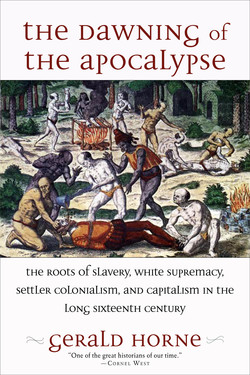The Dawning of the Apocalypse

Реклама. ООО «ЛитРес», ИНН: 7719571260.
Оглавление
Gerald Horne. The Dawning of the Apocalypse
Отрывок из книги
THE DAWNING OF THE APOCALYPSE
The Roots of Slavery, White Supremacy, Settler Colonialism, and Capitalism in the Long Sixteenth Century
.....
Thus, the armed Africans of northern Florida were an obvious counterpoint to the enslaved Africans languishing across the border in what became London’s settlements in Georgia and South Carolina, forcing Britain to expend blood and treasure to extirpate this “threat,” which it did by about 1763, which was then followed by the rebellious settlers intervening more forcefully in Florida over the next half-century or more, until the matter was resolved by the creation of the “Sunshine State” in the slaveholders’ republic. London, then Washington, decided not to build on the “St. Augustine exception” created by Madrid but to strangle it instead. It was left to London, then Washington, to leapfrog Madrid altogether by developing a sturdier axis of colonialism, namely “whiteness,” the privileging of “race” over religion, a process (again) extended by Britain’s erstwhile stepchild in 1776, allowing for the incorporation more readily and easily of a growing number of European immigrants, with little room to compromise with a “Free Negro” population.51
THERE WAS A CONTRADICTORY APPROACH to Africans by Spanish colonizers. There were so-called Black Conquistadors, for example, Juan Garrido, instrumental in the creation of “New Spain” or Mexico, and Sebastian Toral, who obtained his freedom because of his role in the siege of Yucatan, and Juan Valiente, who helped to conquer Guatemala, then settled in Chile. On the other hand, there was a history congruent with subsequent slave revolts within the slaveholders’ republic, for example, that of Miguel in 1553 in the gold-rich region of Venezuela; similar rebellions erupted in like gold mining regions in today’s Colombia in the late sixteenth century. It is possible that thousands of the enslaved murdered their masters and foremen and hid in the mountains and forests, constructing palenques and various forms of marronage that proved difficult to eradicate. Near that same time, in Cuzco in Peru, enslaved Africans and indigenes—in contrast to the Black Conquistadors—formed a rebellious contingent led by an indigene, Francisco Chichima. Due north in Vera Cruz, a citadel was formed in the 1580s by Nanga (Yanga), possibly of Akan or West African origin. About three decades later, the settlers effectuated a kind of entente with these rebels. Perhaps as a partial result, legislation enacted by the monarchs in Madrid and Lisbon were more demanding of masters and more humane toward the enslaved than their peers in London, Paris, The Hague, and especially Washington.52
.....